Winner Winner Chicken Dinner
Yes, I roast a whole chicken in the same appliance I use to toast bread.
Melissa Clark once said, “If you have chicken you have dinner”. I completely agree with that statement and if I may be so bold, I feel like chicken reigns supreme at the dinner table. After all, it can be prepared so many ways and when done properly, it’s so damn good. But despite its popularity and universality, it’s usually never done the justice it deserves. Too often is chicken overcooked and under seasoned. Chicken does not have to be complicated, in fact it should never be complicated. If you’re intimidated by cooking chicken, throw all your fears out the window.
Rely on brands, not labels.
Before we dive into recipes, let’s talk about quality. Like most food in the U.S., much of the chicken sold at grocery stores is subpar. There’s a lot to unpack here, but instead of overwhelming you with grim details (which you can research on your own), I’ll share the guidelines I stick to.
First, the 80:20 rule (sometimes even 70:30). This means 80% of the chicken my family and I consume is of higher quality, while the remaining 20% is reserved for convenience—like eating out or occasionally buying less expensive meat.
Second, I focus on brands rather than labels. From what I’ve learned, food labels in the U.S. often mean very little, especially on animal products. Trusting reputable brands is a safer bet than relying on meaningless stickers. These brands are transparent about their production standards. They offer chicken that’s truly pasture-raised, fed vegetarian feed, and air-chilled (rather than being dunked in cold, bleached water). These factors significantly impact the size and taste of the chicken.
Here are three brands I’ve used. They’re harder to find and more expensive, but not impossible. Mary’s Chicken is the easiest brand to find in my town. A local health food store sells their whole chickens at a fantastic price, so I stock up and keep them in my freezer. You can also buy some of these brands from online purveyors like Misfits Market and Thrive Market.
Mary’s Chicken
Cook’s Venture
Greener Pastures


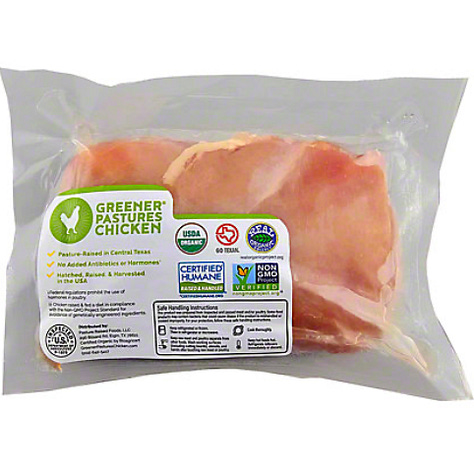
If you’re local, Natural Grocers carries Mary’s Chicken at a great price.
Types of cuts of chicken I prefer to buy.
Bone in skin on chicken breast: For years, chefs and trendy Instagram cooks have pooh-pooed chicken breasts, but I’ve always loved them. The bone keeps the breast incredibly moist, and the skin protects the top of the meat while crisping up into a chef’s treat. If the bone and skin aren’t your thing, simply remove them before eating.
Whole Chickens: The cut I cook the most at home. I absolutely LOVE roasting whole chickens. This might gross some people out, but for me, picking off the tender meat that clings to the bones after carving the bird is the ultimate chef’s treat.
Boneless skinless thighs: Dark meat has its purpose, no doubt. I often use thighs in stir-fries—they add a richness and flavor you can’t get with white meat. Dark meat is also very forgiving, especially if you accidentally overcook it.
If your household usually buys boneless, skinless chicken breasts because you think your family won’t eat other cuts, give it a chance. I promise you’ll be amazed at how much better chicken tastes when cooked with the skin on and bone in. And let’s be real—y’all are already buying those rotisserie chickens from Costco. Same concept, friends!
Chicken do’s and don’ts.
Don’t wash your chicken before cooking. This is a generational and regional cultural thing—my grandparents did it, and my parents did it too. But it’s not necessary. All you need to do is pat the chicken dry with paper towels.
In fact, the USDA advises against washing meat before cooking, as it’s more likely to spread foodborne illnesses than prevent them. So, there you have it. Don’t do it.

Do cut the backs out of your chickens and turkeys! This is called spatchcocking (such a fun word). Similar to splaying—but much easier—spatchcocking helps your birds cook faster, more evenly, and makes carving 10 times easier. All you need are sharp kitchen shears, a good video guide, and a bit of confidence. Once you try it, you’ll never look back. Now, say it with me: “SPATCHCOCK!”
Video of Martha Stewart spatchcocking a chicken
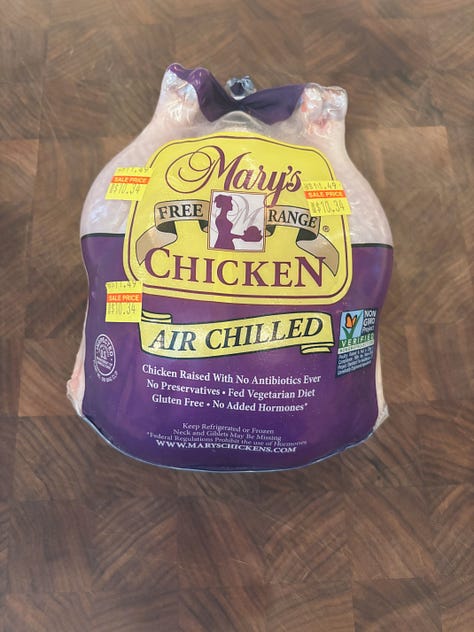
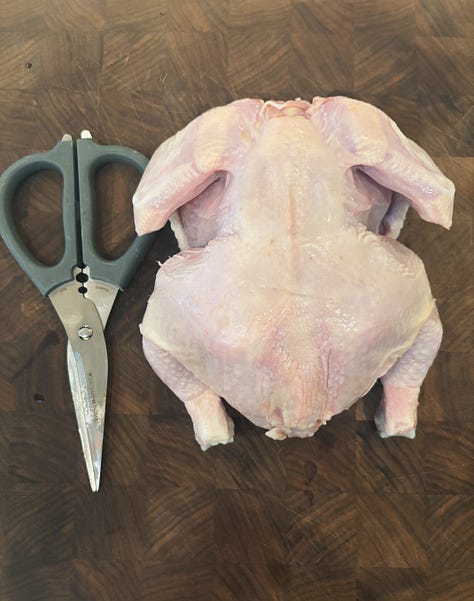

Do use a meat thermometer. When cooking chicken—or any kind of meat—a meat thermometer is a must-have. An inexpensive digital thermometer from Amazon can work wonders in your kitchen and might just be the most underrated gadget. The USDA recommends cooking chicken to an internal temperature of 165°F. However, keep in mind that the temperature will continue to rise as the chicken rests before you cut into it. For perfectly cooked chicken, I pull mine from the heat at 155°F and let it rest for 10–15 minutes. During that time, the temperature will climb the additional 10°F.
Roast chicken buying guide.
Smithey Cast Iron Skillet | Porta NYC Serving Platter | Digital Meat Thermometer |. Nordic Ware Roasting Rack & Tray | Diamond Kosher Salt | Momofuku Savory Salt | Oxo Chicken Shears | The best garlic powder | Za’atar spice blend | Mary’s Organic Chicken
Recipes
My “recipe”
People laugh when I tell them a whole roast chicken is at the top of my list for quick, easy dinners. But it truly is. I even roast mine in my Wolf Gourmet countertop oven—seriously. Yes, I roast a whole chicken in the same appliance I use to toast bread. I don’t follow a recipe, but here’s my “method” for roasting a perfect chicken:
Start with a high-quality whole chicken. Remove the innards (if there are any), then cut out the back with kitchen shears—this process is called spatchcocking. Pat the chicken dry thoroughly with paper towels.
Place the chicken on a sheet pan. If you’re feeling a little extra, you can line the pan with a cooling rack, but it’s totally optional. Drizzle the chicken with a bit of olive oil and generously season both the front and back with salt, pepper, and garlic powder (or granulated garlic). Alternatively, use your favorite seasonings to mix things up. Try to get that seasoning (especially the salt) under the skin too.
Place the chicken skin side up in a 425°F oven. If your oven has a Convection setting, use it. If it has a Convection Roast setting, use that too. Just be sure to reduce the temperature to 400° if you’re using Convection.
Roast the chicken until it’s golden brown and an instant-read thermometer shows a temperature between 150°F and 165°F all over, which usually takes about 30–40 minutes, depending on the size of the bird. I start checking after 25 minutes to see how quickly it’s cooking.
This may seem straightforward, but getting the thermometer in the right spot for an accurate reading takes practice. Be sure to check the temperature in both the breasts and the thighs. Don’t be afraid to poke it all over few times at first—just to get multiple readings of the internal temp.
Remove the chicken from the oven and let it rest for at least 10 minutes! To serve, cut between the two breasts, then separate the thigh and leg. If carving the bird intimidates you, just treat it like a Costco rotisserie chicken and dig in with your hands. Who cares? It’s your meal!
I can’t emphasize this enough: the most important part is saving all the drippings from the pan. What I like to do is carve the chicken directly on the sheet pan to catch all the juices, then use a spatula to scrape up the fond and schmaltz (those delicious fatty brown bits) and mix it with the juices. This sauce is liquid gold. Honestly, I end up eating my chicken right off the roasting pan. It’s that good!
What is Schmaltz?
Schmaltz is rendered chicken—basically, the drippings. This is why we love the fat on our chicken—it adds incredible flavor and creates the most savory “sauce.” Here’s an old video I found on my phone of a roast chicken I made in a cast-iron skillet instead of a sheet pan. You can literally hear the schmaltz bubbling under the chicken. Very schmaltzy, baby!
More recipes to try:
Roast Chicken with Schmaltzy Cabbage by Smitten Kitchen. I love cabbage and I love schmaltz. And the cabbage acts like the side dish to your chicken.
Peruvian Roasted Chicken with Spicy Cilantro Sauce by Melissa Clark: I haven’t made this recipe in a while. It’s a bit more effort than my usual roast chicken, but it’s absolutely delicious. The reviews speak for themselves. Any chicken recipe with an herby verde sauce is always going to be a great idea!
Lemon Chicken by Ina Garten: This was probably the first “roast” chicken recipe I ever made (back in high school, probably). It only uses chicken breasts, so it’s a great starter recipe if you’re not sure you want to tackle a whole bird. It creates a very lemony and savory sauce that’s absolutely delicious.
Za’atar Chicken Sheet Pan Dinner by Modern Proper: I’ve never made this recipe, but Za’atar (a Turkish spice blend) might be the greatest seasoning on earth for chicken—ever! Also, I love a chicken recipe that includes veggies to make it a complete meal. That’s what I call a winner, winner, chicken dinner!
I’m loving ground chicken right now.
Call me late to the game, but I’ve recently discovered a love for ground chicken. Probably because of my hubby’s new obsession with calorie and protein counting at the moment, I’ve been cooking with a lot of ground chicken lately. My biggest complaint in the ground poultry world is that it’s very hard to find ground chicken from my favorite quality brands. I’m this close to buying a meat grinder. Here are two of my recent ground chicken recipes on repeat.
CHICKEN PARMESAN MEATBALLS
Was honestly blown away by how delicious these are and how quickly they came together. I used a combination of 3 recipes I found online and the rest is history. I served ours over zucchini noodles and the kids over regular noodles. Can’t wait to make again.
SPICY CHICKEN LETTUCE WRAPS
Unpopular opinion, but I prefer my lettuce wraps to be less tangy and fish-saucy and more savory and umami-y. These fit the bill and my entire family (toddlers and all) loved these. Also, I prefer iceberg over butter lettuce—the crunch of iceberg is too satisfying. My kids got a kick out of frying bean threads too.
Ordering the chicken at a high-end restaurant.
Most “foodies” (gosh, I hate that word) will tell you that ordering the chicken at a restaurant is a red flag, a bad call, or a faux pas. In my opinion, if a restaurant has a small, well-curated menu and chooses to include a roast chicken, it probably means the dish is incredible. This was the case with the Pollo E Crostone at Antico Nuovo. Let me set the scene: a fire-roasted bird nestled on top of the crustiest bun of focaccia soaked in chicken juice and topped with a tangy salsa verde. What chicken dreams are made of. We ate a lot that night.
That’s all I have to say about chicken, for now. Happy cooking and as always, thanks for reading! Please feel free to share on your social platforms.
Xx Kayla





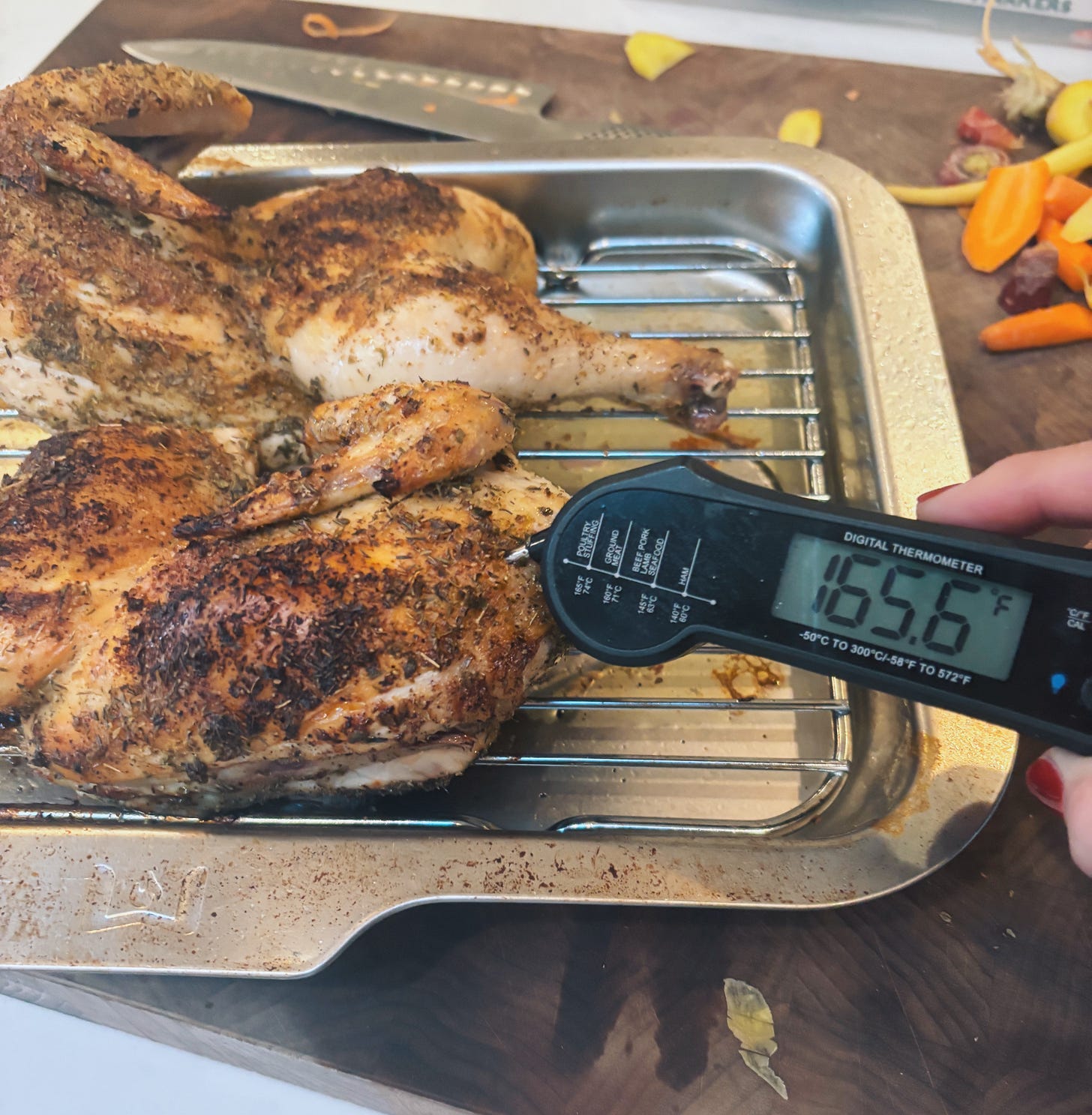



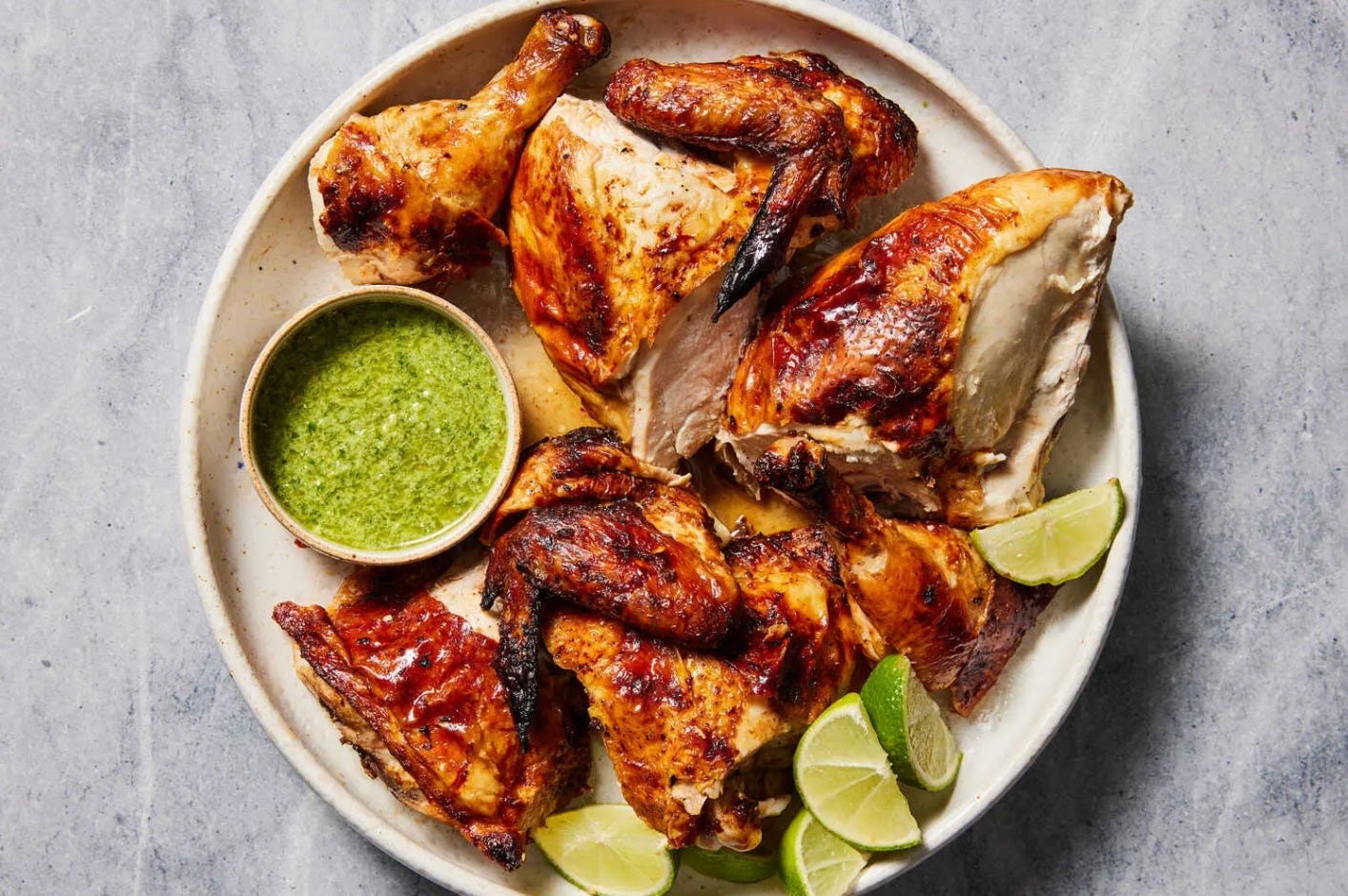





I keep coming back to these recipes! Making again tonight
No discussion. Just feel inspired. Thanks for the Natural Grocers Mary’s chicken tip!!!!